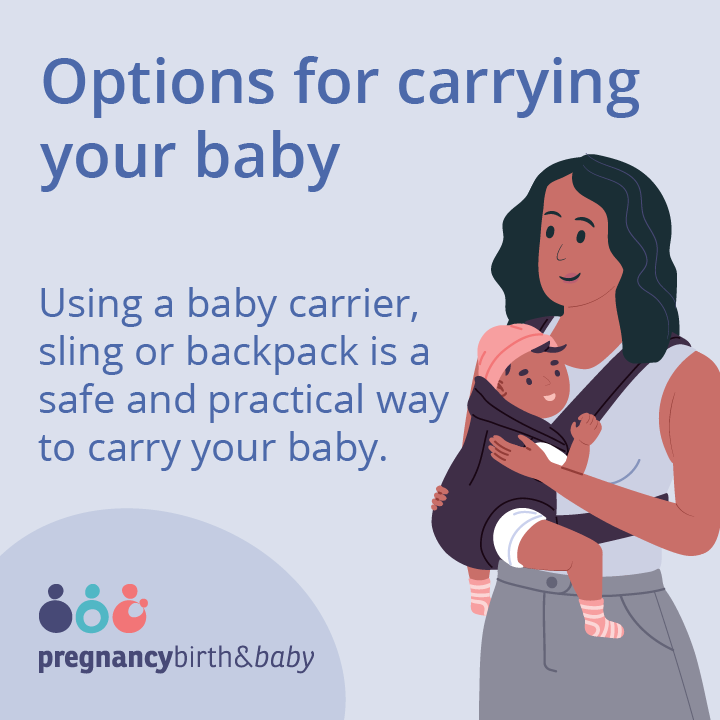Baby carriers, slings and backpacks
7-minute read
Key facts
- You can choose to carry your baby in your arms or use a baby carrier, sling or backpack.
- If you use baby carriers, slings and backpacks correctly, they are safe and practical ways to carry your baby.
- Always choose a product that suits your baby’s age and size — some products are not suitable for newborns or premature babies.
- If your baby has a health condition like hip dysplasia or reflux, ask your healthcare team about the safest way to carry them.
- Your cultural preferences, baby’s physical health and personal comfort all play a role in finding the best way to carry your baby.
How can I carry my baby?
Most babies are carried in arms or pushed in prams and strollers. Other ways to carry your baby are using products such as:
- baby carriers
- slings
- baby backpacks
Carrying your baby close using these products can be a wonderful way to bond with your baby, settle them or let them sleep on you, all while keeping your hands free for everyday tasks.
Carriers, slings and backpacks can help you move around more easily while keeping your baby safe and comforted. Babywearing (using a baby carrier) can also help with breastfeeding.
There are many ways to carry your baby, and each way has its own benefits. It’s important to choose an option that is not only safe and comfortable, but also suits your baby’s age, physical needs and your family’s lifestyle.
Your cultural preferences, physical health and personal comfort all play a role in finding the best way to carry your baby.

What is a baby carrier?
A baby carrier is a soft or structured item that you wear on your front, back or side. It has straps and buckles that help carry your baby safely.
Some carriers are made for newborns, while others are better for older babies who can sit up on their own. Some come with newborn inserts for extra support.
Carriers are useful for everyday use, around the home and to get out and about.
There are many baby carriers available from different companies. It is important to do your research and ask for recommendations from friends, family or other parents in your community.
What is a baby sling?
A baby sling is a long piece of fabric worn over one shoulder and across your body. It makes a little pouch for your baby to rest in while carried.
Types of slings include:
- ring slings — these have rings to adjust the fit
- wrap slings — these are long pieces of fabric you wrap and tie around your body
It is important that you correctly position the sling so your baby can breathe safely.
When considering a baby sling, you should research different products and ask for recommendations from friends, family or other parents in your community.
What is a baby backpack?
A baby backpack is a firm, structured carrier that you wear on your back, like a hiking backpack.
Only use a framed carrier for babies who can hold their head and neck on their own — young babies are at risk of neck injuries. If you are unsure if a baby backpack is suitable for your baby, speak to a healthcare professional.
Is it safe to carry my baby in a carrier, sling or backpack?
It is safe to use a carrier, sling or backpack to carry your baby, if it is used the right way. Some babies need extra care in a carrier, especially if they are at risk of sudden infant death syndrome (SIDS). Examples include if they:
- were born early
- had a low birth weight
- have breathing problems
If your baby is less than 4 months old, it’s important to be extra careful and make sure they’re in a safe position when you carry them.
Here are some tips to consider when choosing how to carry your baby:
- Make sure the product suits your baby’s age, size and development.
- Always support your baby’s head and neck if they can’t hold it up on their own.
- Make sure you can see your baby’s face, and that their nose and mouth are clear of anything that could block air flow.
- Check your baby for overheating, especially in hot weather.
- Follow 'T.I.C.K.S' safety rules.
If your baby has a health problem like reflux, hip problems or another medical condition, speak with your doctor before using a carrier, backpack or sling.
What is TICKS?
TICKS is a simple way to remember how to carry your baby safely:
- Tight — the carrier should hold your baby snugly against you
- In view at all times — always make sure you can see your baby’s face
- Close enough to kiss — you should be able to kiss the top of their head
- Keep chin off chest — their chin should not be resting on their chest
- Supported back — their back should be straight and not slumped
What should I consider when buying a carrier, sling or backpack?
Choosing a baby carrier, sling or backpack is a personal decision. What matters most is safety and comfort.
In Australia, there are no mandatory safety standards for baby carriers, slings or backpacks. There are Australian product safety standards that manufacturers and parents can follow to help keep babies safe.
Here are some tips to consider when picking the best carrier for you and your baby:
- Check the label to see what age and weight the product is made for.
- Try it on if you can — is it easy to use on your own?
- Look for good airflow, especially if you live in a warm place.
- Make sure it’s comfortable for you — padded straps and waistbands can help.
- Choose a design that fits your lifestyle or culture.
- Watch videos from trusted sources to learn how to use your carrier properly.
- If you are unsure, ask for help or advice from a child health nurse, other parents with babies, friends or family.
Resources and support
For more information and support:
- Red Nose Australia has a useful guide for slings and baby carriers.
- The Queensland Government offers further information about baby slings and a video on How to keep your baby safe in a sling.
- Product Safety Australia has a guide to baby carriers, wraps and slings.
- Product Safety Australia also has a guide to buying safe second-hand products online.
- Australian Breastfeeding Association has information to help you choose a baby carrier.
Looking for information for Aboriginal and/or Torres Strait Islander people?
Red Nose Australia has resources on safe sleeping for Aboriginal and/or Torres Strait Islander peoples. You can also book a yarning with a midwife on 1300 998 698.
Do you prefer to read in languages other than English?
Kidsafe has translated resources on how to keep children safe including a brochure on baby slings and carriers, in a range of community languages.

Speak to a maternal child health nurse
Call Pregnancy, Birth and Baby to speak to a maternal child health nurse on 1800 882 436 or video call. Available 7am to midnight (AET), 7 days a week.
Learn more here about the development and quality assurance of healthdirect content.
Last reviewed: May 2025







